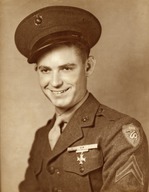
|

|
|
|
|
Born in Belmont, Louisiana, Clayton was one of eight children of Leonard and Pearl McFerrin. As a youngster he lived on the family farm where his father grew cotton (Clayton helped pick it), corn, and sugar cane, as well as vegetables and fruits his mother canned. They also preserved pork in a smokehouse. Although raised in the Depression, he says, his family never went hungry. Clayton recalls an African-American woman, Aunt Melee, who helped his mother with housework, and was known for her excellent cooking. Often, the family visited Aunt Melee's church where her husband was pastor, especially on the Sundays when they had "dinner on the ground." Clayton rode a horse to the Adkins School, about two-and-a-half miles from his home, taking in a syrup bucket his lunch of a pint fruit jar of milk and smoked meat and biscuits. In 1934, the family moved to Shreveport, where Leonard worked for Libbey Owens Ford Glass Factory. Clayton entered Byrd High School, but dropped out after the ninth grade, and entered the newly opened Shreveport Trade School, where he learned mechanics. He was working at an A&P grocer when the Japanese attacked Pearl Harbor. A day later, Clayton enlisted in the U.S. Marine Corps. In boot camp he was hospitalized with an illness, forcing him to take training again, once he recovered. After boot camp and Motor Transport School, he was assigned to the 22nd Marine Regiment, 1st Provisional Brigade, and shipped out to Wallace Island in American Samoa. "Guard duty," he recalls of his fifteen months of service there, where the Marines built airports, harbors, and roads. He was shipped to Maui, Hawaii, for combat training, then made the landing at Eniwetok on February 17, 1944, where he saw many fellow Marines die. "Those Japs were waiting for you and they were mowing them down as fast as they hit the beach," he recalls of the landings. "But there were enough of us getting in there that every once in a while one of 'em would go all the way in. I was lucky. I never did get in the first wave. I was always far enough back that some of those boys that died had took enough real estate for me to cut me a foxhole." The fighting there and nearby on Kwajalein was "horrible," he remarks. "There was fighting from the time we landed at the beachheads," he says. Often, he recalls, Japanese, drunk from saki and high on opium, made desperate charges. "They'd get to feeling pretty good and they'd get to hollering, and they'd come down there shooting. They couldn't hit the side of a barn they'd be so high. You could just stand there and mow them down like you're cutting grass," he says. Japanese dead, he reports, were dumped in deep water. "The sharks would just take care of the rest of it," he remarks. Clayton recalls building an airstrip that joined the two islands for a B-29 base. He saw Eleanor Roosevelt when she visited troops in the Pacific, and, while sitting in a foxhole on Guam, voted for her husband in the 1944 presidential election. Clayton returned to America in November of 1944 and was stationed at a naval base near Houma, Louisiana. On June 19, 1945, he married Doris Hendricks. (They would have four children, seven grandchildren, and seven great-grandchildren.) On VJ-Day, August 14, 1945, he was aboard a troop train in Bay St. Louis, Mississippi. "People were really crazy," he says of the reaction to Japan's surrender. "They were hollering and screaming and running around and throwing stuff. The train couldn't even move." Clayton received his discharge on October 3, 1945. He took a job as a mechanic for R.F. Kaiser Trailer Company in Shreveport, then spent a twenty-eight-year career with Libbey Owens Ford Glass Company. |


